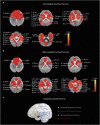Prenatal maternal depression alters amygdala functional connectivity in 6-month-old infants
- PMID: 25689569
- PMCID: PMC4445753
- DOI: 10.1038/tp.2015.3
Prenatal maternal depression alters amygdala functional connectivity in 6-month-old infants
Abstract
Prenatal maternal depression is associated with alterations in the neonatal amygdala microstructure, shedding light on the timing for the influence of prenatal maternal depression on the brain structure of the offspring. This study aimed to examine the association between prenatal maternal depressive symptomatology and infant amygdala functional connectivity and to thus establish the neural functional basis for the transgenerational transmission of vulnerability for affective disorders during prenatal development. Twenty-four infants were included in this study with both structural magnetic resonance imaging (MRI) and resting-state functional MRI (fMRI) at 6 months of age. Maternal depression was assessed at 26 weeks of gestation and 3 months after delivery using the Edinburgh Postnatal Depression Scale. Linear regression was used to identify the amygdala functional networks and to examine the associations between prenatal maternal depressive symptoms and amygdala functional connectivity. Our results showed that at 6 months of age, the amygdala is functionally connected to widespread brain regions, forming the emotional regulation, sensory and perceptual, and emotional memory networks. After controlling for postnatal maternal depressive symptoms, infants born to mothers with higher prenatal maternal depressive symptoms showed greater functional connectivity of the amygdala with the left temporal cortex and insula, as well as the bilateral anterior cingulate, medial orbitofrontal and ventromedial prefrontal cortices, which are largely consistent with patterns of connectivity observed in adolescents and adults with major depressive disorder. Our study provides novel evidence that prenatal maternal depressive symptomatology alters the amygdala's functional connectivity in early postnatal life, which reveals that the neuroimaging correlates of the familial transmission of phenotypes associated with maternal mood are apparent in infants at 6 months of age.
Figures


References
-
- Pawlby S, Hay DF, Sharp D, Waters CS, O'Keane V. Antenatal depression predicts depression in adolescent offspring: prospective longitudinal community-based study. J Affect Disord. 2009;113:236–243. - PubMed
-
- MIAN AI. Depression in pregnancy and the postpartum period: balancing adverse effects of untreated illness with treatment risks. J Psychiatr Pract. 2005;11:389–396. - PubMed
-
- Sohr-Preston SL, Scaramella LV. Implications of timing of maternal depressive symptoms for early cognitive and language development. Clin Child Family Psychol Rev. 2006;9:65–83. - PubMed
-
- Lundy B, Field T, Pickens J. Newborns of mothers with depressive symptoms are less expressive. Infant Behav Dev. 1996;19:419–424.
Publication types
MeSH terms
LinkOut - more resources
Full Text Sources
Other Literature Sources
Medical

